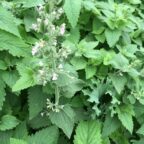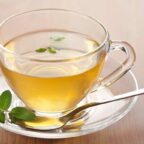Not just for cats!
- Catnip can be used as an herbal beverage (tea).
- The essential oils can be used as a bug repellent.
- The flowering tops are used to make medicine for people and pets.
- It is an aphid repellent when it is growing.
- Flowers are very attractive to bees.
- And your cats will love you for getting it.
“Catnip’s leaves and shoots have been used as a flavoring in sauces, soups, and stews, and in several patented beverages, as well as in fruit table wines and liquors. The use of catnip leaves and flowers in herbal teas was documented at least as early as 1735 in the General Irish Herbal. Medicinally, the plant has been used to treat intestinal cramps, for indigestion, to cause sweating, to induce menstruation, as a sedative, and to increase appetite. Additionally, the plant has been used to treat diarrhea, colic, the common cold, and cancer. In Appalachia, nervous conditions, stomach ailments, hives, and the common cold have been treated with catnip tea. The dried leaves have been smoked to relieve respiratory ailments, and a poultice has been used externally to reduce swelling. In the early 1900s, the flowering tops and leaves were used to induce delayed menses.” ~ Drugs.com
Harvest individual leaves when the plants have become established. To dry, hang branches upside down in a well-ventilated, dry location out of sunlight.
Catnip Tea
To make catnip tea, mix 2 teaspoons of dried catnip leaves or flowers with 1 cup of boiling water. Add lemon juice and honey, stir, and let cool for several minutes. Many people prefer a steeping time of about 10 to 15 minutes. Catnip tea has a woodsy, almost grassy taste.
***PERFECT FOR OUTSIDE DIRT GARDENS, CONTAINERS, AND FLOWER POTS TOO!***
GROWN ALL YEAR IN THE TOWER GARDEN
SEED: Catnip Herb Seed from Johnny’s Selected Seeds
LATIN NAME: Nepeta cataria
DAYS TO MATURITY: 75 to 85 days













